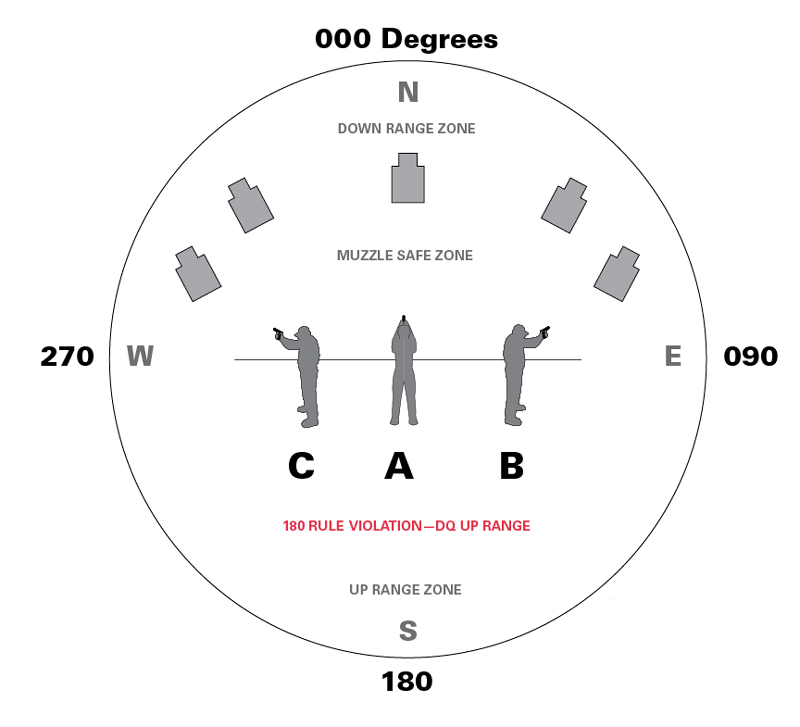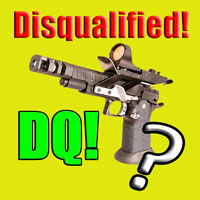Shooting Competition Disqualifications Pave The Way For Gun Safety
By Jay Cummings

When attending any handgun competition, it is typical to hear someone say “there are only two types of shooters… those who have been disqualified (DQ) from a match, and those who will be.” Why is that? What even gets a person disqualified? The answer is simple, safety violations can.(1) While the responsibility of proper gun handling falls on all shooters, competition shooters are leading the way by following The 180 Rule. Shooting Competition Disqualifications Pave The Way For Gun Safety
First, it’s important to note that handgun competitions are for all shooters, not just professionals. Both The International Defensive Pistol Association (IDPA) and The United States Practical Shooting Association (USPSA) welcome shooters of any ability level! Is there a better way to learn than to be surrounded by other experienced shooters? It is important to remember that one point in time, everyone was a beginner. These organizations and competition veterans know that and help to facilitate a safe environment for all shooters to enjoy the sport.
It’s common knowledge that guns have the potential to be dangerous. That being said, accidents in this environment are to be avoided at all costs. Mistakes revolving around gun safety are oftentimes due to user error. Competition shooters bear this responsibility with pride. As a result, violations in this environment are met with strict consequences—immediate disqualification. The shooter will be promptly asked to unload their firearm, pack their bags, and supervised as they leave the location. They are done for the day. This “one strike rule” is used to highlight the importance of safety. “Unsafe gun handling will not be tolerated” when they have 2 the potential to cause serious consequences.
This sobering moment can happen to anyone. This includes the “pro’s” and new shooters alike. While a beginner may become unsafe without even knowing it. Their actions are oftentimes due to the absence of the safety rules being deeply ingrained. An expert can break a rule—with full awareness. In the heat of competition, shooters may occasionally “toe the line” for the sake of speed and efficiency. With time playing a large component in getting a good score, it can be tempting to try and cut corners. Subsequently, shooters of all ability levels can get disqualified.
One of the firearm safety rules is to always keep guns pointed in a safe direction. What is a safe direction? At any range, the only safe direction to face a firearm is down range. This is typically signified by a barrier or bright colored line on the ground in a straight line across the entire range, also known as the firing line. Anything in front of this line could be in danger. The premise for this regulation is prevent the shooter from pointing the gun at anything they would not want to destroy (anything at the range excluding targets). In a competition, when shooters are moving as fast as they can to complete a course of fire, this is one of the easiest rules to break.
Shooting Sports USA explains how “there are many different ways a shooter can receive a DQ, and the most common is violation of the 180 Rule.” The 180 Rule establishes what is and 3 is not a safe direction. At most ranges, this rule can be followed simply by keeping a gun’s muzzle over the firing line and shooting targets are down range. However, in competition, when shooters may have to move in order to accomplish their task, staying safe becomes more complex. To follow the 180 rule, a competitor cannot rotate the gun anything past 180 degrees parallel to the firing line. Anything past this will result in a DQ. Between all of the fast movements and targets scattered all around—it may not be surprising that shooters can become unsafe and be disqualified.
I came to realize how easily safety violations can occur at my very first handgun competition. I remember the moment like it was in slow-motion; as the competitor unconsciously moved to shoot his next target—barely, just barely breaking the 180. Even so, pointing a gun in an unsafe direction, to any degree, will never be tolerated. The DQ served as a good reminder to everyone on range. A reminder to stay focused and never let your guard down. Gun safety should always be taken seriously. I am thankful that competition shooters understand this responsibility and steward it well.
Here are some pictures to help convey The 180 Rule:


Chris Christian, “Avoiding the 180 DQ,” An NRA Shooting Sports Journal, April 18, 2017, 1 https://www.ssusa.org/content/avoiding-the-180-dq/.
Ibid. 2
Ibid. 3

